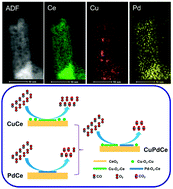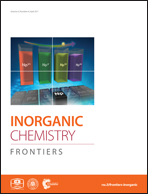Synthesis and metal–support interaction of subnanometer copper–palladium bimetallic oxide clusters for catalytic oxidation of carbon monoxide†
Abstract
Subnanometer oxide clusters with distinct metal–support interactions have attracted great interest due to their possible superiority in catalytic performance compared to that of conventional metal–oxide nanoparticles. In this paper, we report the solution-based chemical synthesis of a new type of copper–palladium bimetallic oxide clusters anchored to the surface of ceria nanorods. Revealed by aberration-corrected high-angle annular dark-field scanning transmission electron microscopy (HAADF-STEM) and X-ray absorption fine structure (XAFS) techniques, we have identified that both copper and palladium species are fully oxidized with dominant metal–support interaction contributions by a strongly bound M–Ox–Ce (M = Cu or Pd) structure. However, no direct bond between copper oxide and palladium oxide clusters, i.e. Cu–Ox–Pd, has been verified by experimental evidences, and thus no synergistic effect on the catalytic activity of bimetallic copper–palladium oxide clusters, compared to that of single metal (palladium) oxide clusters, has been demonstrated for the CO oxidation reaction.



 Please wait while we load your content...
Please wait while we load your content...